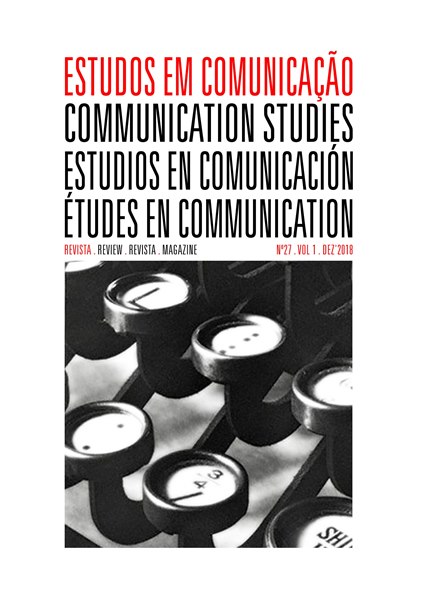Perspective of neuroscience in communication
Keywords:
neurociência em comunicação, neurocomunicação, design science research, pragmatismo utópico.Abstract
Bibliographical research aiming to consolidate the current stage of the intersection between neuroscience and communication. We use a multidisciplinary theoretical framework with the objective of offering
investigative insights and keys of understanding. Divided into three parts: understanding neuroscience and its interface with communication; to investigate neuroscience technologies and their applications in communication; and evaluate the feasibility of using the Design Science Research methodology in the communication-neuroscience interface.
We understand that there is room for a systematic investigation and that the use of this methodology is feasible, considering a utopian pragmatic
orientation.
References
Bear, M. F.; Connors, B.W. & Paradiso, M. A. (2002). Neurociências: desvendando o sistema nervoso. Porto Alegre: Artmed. Disponível em: www.jvasconcellos.com.br/fat/FAT_BIO/wpcontent/
uploads/2014/09/Livro-de-Fisiologia-Neuroci%C3%AAncias-Desvendando-o-siste
ma-nervoso-Bear-M.-F.-Connors-B.-W.-Paradiso-M.-A.pdf. Acesso em: 29 nov. 2016.
Castro, C.; Tome, T. & Barbosa Filho, A. (2005). Midias Digitais. São Paulo: Paulinas.
Cogan, G. B. et al. (2014). Sensory–motor transformations for speech occur bilaterally. Nature, 507(7490): 94-98. Disponível em: www.nature.com/doifinder/10.1038/nature12935. Acesso
em: 1 dez. 2016.
Costa, D. C.; Oliveira, J. M. A. P. & Bressan, R. A. (2001). PET e SPECT em neurologia e psiquiatria: do básico às aplicações clínicas. Revista Brasileira de Psiquiatria, 23: 4-5. Disponível
em: www.scielo.br/scielo.php?script=sci_arttext&pid=S1516-44462001000500003&lng=pt
&nrm=iso&tlng=pt. Acesso em: 3 dez. 2016.
Crew, B. (s.d.). Scientists have invented a mind-reading machine that visualises your thoughts - ScienceAlert. Disponível em: www.sciencealert.com/scientists-have-invented-a-mind-readin
g-machine-that-can-visualise-your-thoughts-kind-of.
Dresch, A. (2015). Design Science Research. Porto Alegre: Bookman.
Duarte, J. & Barros, A. (2006). Métodos e técnicas de pesquisa em comunicação. São Paulo: Atlas.
Gazzaniga, M.; Ivry, R. B.; Mangun, G. R. (2006). Neurociência cognitiva: a biologia da mente. Porto Alegre: Artemed.
Grau, C. et al. (2014). Conscious Brain-to-Brain Communication in Humans Using Non-Invasive Technologies. PLoS ONE, 9(8): e105225. Disponível em: http://dx.plos.org/10.1371/journal.
pone.0105225. Acesso em: 4 out. 2016.
Harari, Y. (2015). Sapiens: uma breve história da humanidade. Porto Alegre: L&PM.
Huth, A. G. et al. (2016). Natural speech reveals the semantic maps that tile human cerebral cortex. Nature, 532(7600): 453-458 . Disponível em: www.nature.com/doifinder/10.1038/nature176
Acesso em: 26 nov. 2016.
Kaku, M. (2011). A física do futuro. São Paulo: Rocco.
Kaku, M. (2015). The future of mind: The scientific quest to understand, enhance, and empower the mind. New York: Anchor Books.
Kawano, D. (2014). Publicidade e neurociência: uma revisão bibliométrica. Foz do Iguaçu: Intercom.
Kurzweil, R. (2013). How to create a mind. New York: Penguin.
Lee, H. & Kuhl, B. A. (2016). Reconstructing Perceived and Retrieved Faces from Activity Patterns in Lateral Parietal Cortex. Journal of Neuroscience, 36(22).
Lemos, A. (2005). Cibercultura e Mobilidade. A Era da Conexão. Rio de Janeiro: Intercom.
Maclean, P. D. (1990). The Triune Brain in Evolution: Role in Paleocerebral Functions - P.D. MacLean – Google Livros. New York: Plenum. Disponível em: https://books.google.com.br/boo
ks?id=4PmLFmNdHL0C&printsec=frontcover&hl=pt-BR&source=gbs_ge_summary_r&ca
d=0#v=onepage&q&f=false.
McClure, S. M. et al. (2004). Neural Correlates of Behavioral Preference for Culturally Familiar Drinks. Neuron, 44: 379-387.
Nicolelis, M. (2011). Muito além do nosso eu. São Paulo: Companhia da Letras.
Nishimoto, S. et al. (2011). Reconstructing Visual Experiences from Brain Activity Evoked by Natural Movies. Current Biology, 21(19): 1641-1646. Disponível em: http://linkinghub.else
vier.com/retrieve/pii/S0960982211009377. Acesso em: 26 nov. 2016.
Reardon, S. (2016). Laser used to control mouse’s brain – and speed up milkshake consumption. Nature. Disponível em: www.nature.com/doifinder/10.1038/nature.2016.20995. Acesso em: 18 nov. 2016.
Squirra, S. (org.) (2012). Ciber midias: extensões comunicativas, expansões humanas. Porto Alegre: Buqui.
Squirra, S. C. (2016). A tecnologia e a evolução podem levar a comunicação para a esfera das mentes. São Bernardo do Campo: [s.n.].
Weber, R.; Mathiak, K. & Sherry, J. (2009). The neurophysiological perspective in mass communication research: theoretical rational,methods, and applications. In M. J. Beatty, J. C.
McCroskey & K. Floyd (orgs.), Biological Dimensions of Communication: Perspectives, Methods, and Research (pp. 41-71). New York: Hampton.
Wolton, D. (2011). Informar não é comunicar. Porto Alegre: Sulina.
Zarkadakis, G. (2015). In our own image. New York: Pegasus.
Downloads
Published
Issue
Section
License
Estudos em Comunicação/Communication Studies is an Open Access journal. All its content is freely available without charge to the user or his institution. Users are allowed to read, download, copy, distribute, print, search, or link to the full texts of the articles in this journal without asking prior permission from the publisher or the author. Estudos em Comunicação, by Labcom, is licensed under a Creative Commons Atribuição-NãoComercial-SemDerivações 3.0 Unported License. By submitting your work to Estudos em Comunicação/Communication studies you confirm you are the author and own the copyright, that the content is original and previously unpublished, and that you agree to the licensing terms.


